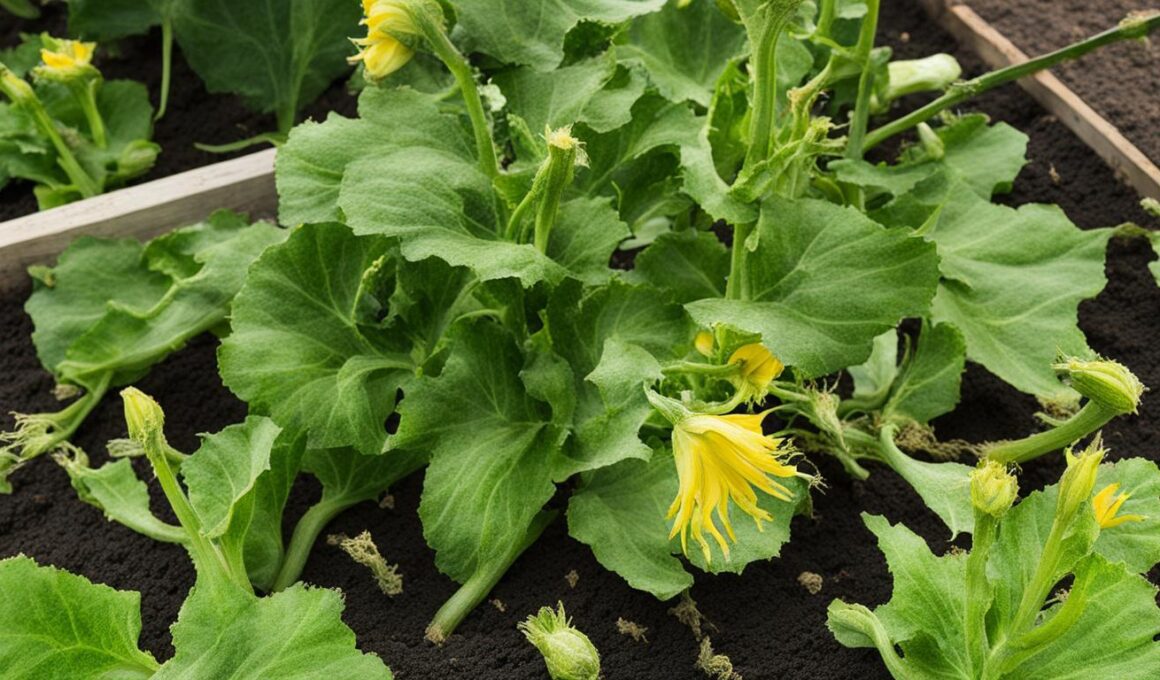Welcome to our gardening guide on how to spot and prevent zucchini blossom end rot. If you’re a zucchini enthusiast, you know how disappointing it can be to find dark, rotting areas on the blossom end of your precious squash. But fear not, because we’re here to help you keep your zucchinis healthy and thriving!
Zucchini blossom end rot is a common condition caused by a calcium deficiency in the fruit. Factors such as extreme soil moisture fluxes, over-fertilization, and root damage can contribute to this problem. However, by implementing some preventive measures, you can ensure a bountiful harvest of beautiful, rot-free zucchinis.
So, how can you prevent blossom end rot on your zucchinis? It starts with testing your soil for calcium levels before planting. This will give you a baseline understanding of the soil’s nutrient composition and help you make informed decisions about fertilization.
Consistent irrigation is key in preventing this condition. Zucchinis prefer evenly moist soil, so make sure to water them regularly, especially during dry spells. Mulching around the plants can also help retain moisture and prevent fluctuations in soil moisture levels.
Another crucial aspect of prevention is avoiding root damage during cultivation. Be gentle when working around your zucchinis and take care not to disturb their delicate roots. Additionally, providing proper fertilization with micronutrients, such as calcium, is essential for healthy fruit development.
By following these preventive measures, you’ll be on your way to a healthy and bountiful zucchini harvest. However, if you do happen to spot blossom end rot on your plants, don’t worry—we’ll cover treatment options in later sections to help you address the issue effectively.
Keep reading our guide to learn more about the causes of blossom end rot and how to effectively treat this condition. With our tips and techniques, you’ll be able to enjoy a flourishing zucchini garden and savor the fruits of your labor!
Causes of Blossom End Rot on Zucchini Squash
Blossom end rot on zucchini squash is primarily caused by a calcium deficiency in the soil, which adversely affects the growth of cell walls in the fruit. When there is insufficient calcium available, the cells in the fruit collapse, starting from the weaker cells located at the blossom end. This results in a dark, rotting area on the fruit.
Several factors can contribute to calcium deficiency and the development of blossom end rot. Extreme soil moisture fluxes, such as alternating periods of drought and heavy rainfall, can disrupt the absorption and transport of calcium within the plant. Over-fertilization, particularly with high nitrogen fertilizers, can also interfere with calcium uptake. Additionally, any root damage sustained during cultivation can impede the plant’s ability to acquire calcium efficiently.
Plants that bear heavily and have a high demand for calcium are more susceptible to blossom end rot. The rapid fruit growth coupled with inadequate calcium supply leads to the development of this condition.
To effectively manage blossom end rot, it is essential to understand and address these underlying causes. By addressing calcium deficiency and minimizing the contributing factors, you can help prevent the occurrence of this frustrating issue in your zucchini squash plants.
Prevention of Blossom End Rot on Zucchinis
To ensure a healthy zucchini harvest, it’s essential to prevent blossom end rot from occurring in the first place. By following these preventive measures, you can maximize your chances of a successful crop:
- Soil Testing: Before planting your zucchini, test the soil to check for calcium levels. Low calcium levels can contribute to blossom end rot. If the soil is deficient in calcium, you can address the issue by amending the soil with calcium-rich products.
- Consistent Irrigation: Maintaining consistent moisture levels in the soil is crucial for preventing blossom end rot. Zucchinis require regular, deep watering to ensure the roots are consistently hydrated. Avoid overwatering or allowing the soil to dry out completely.
- Avoiding Root Damage: During cultivation, take care to avoid damaging the roots of your zucchini plants. Root damage can hinder nutrient uptake, including calcium absorption, leading to blossom end rot. Be cautious when weeding or working around the plants.
- Proper Fertilization: Providing your zucchinis with proper fertilization is key to preventing nutrient deficiencies. Choose a balanced fertilizer that includes micronutrients like calcium. Avoid using high nitrogen fertilizers or ammonia-based fertilizers, as they can interfere with calcium absorption.
By implementing these preventive measures, you can create optimal growing conditions for your zucchinis, minimizing the risk of blossom end rot and ensuring a bountiful harvest.
Conclusion
Zucchini blossom end rot is a common issue that can significantly impact the health of your zucchini harvest. However, with proper care and attention, you can prevent this condition and ensure a bountiful and healthy harvest. By following a few key steps, you can minimize the risk of blossom end rot and enjoy an abundance of delicious zucchinis.
To prevent blossom end rot, it is crucial to start with soil testing to assess the calcium levels. This will help you understand if any deficiencies exist and allow you to make necessary amendments. Additionally, maintaining consistent irrigation is essential, as extreme soil moisture fluxes can lead to nutrient imbalances and contribute to blossom end rot.
Furthermore, it is important to avoid root damage during cultivation, as this can impair the plant’s ability to absorb nutrients, including calcium. Finally, ensure you provide proper fertilization with micronutrients, as they play a critical role in the overall health and development of your zucchini plants.
If, despite your best efforts, blossom end rot does occur, treatment options are available. You can add calcium directly to the soil at the base of the plant, addressing the calcium deficiency directly. Alternatively, using calcium through a drip system can help deliver the necessary nutrients more efficiently to the affected plants. By taking prompt action, you can minimize the impact of blossom end rot and continue to nurture a healthy zucchini harvest.
Will Pruning Zucchini Help Prevent Blossom End Rot?
Pruning zucchini tips are essential for preventing blossom end rot. By trimming off excess foliage, you can improve air circulation and reduce the risk of the disease. This simple technique can also help redirect the plant’s energy towards fruit production, resulting in a healthier zucchini harvest.










